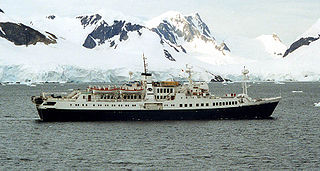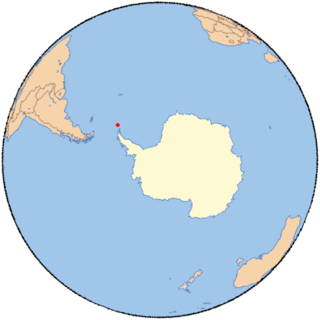Related Research Articles

Vega Island is an island in Antarctica, 17 nautical miles long and 6 nautical miles wide, which is the northernmost of the James Ross Island group and lies in the west part of Erebus and Terror Gulf. It is separated from James Ross Island by Herbert Sound and from Trinity Peninsula by Prince Gustav Channel.

Joinville Island group is a group of antarctic islands, lying off the northeastern tip of the Antarctic Peninsula, from which Joinville Island group is separated by the Antarctic Sound.

Seymour Island or Marambio Island, is an island in the chain of 16 major islands around the tip of the Graham Land on the Antarctic Peninsula. Graham Land is the closest part of Antarctica to South America. It lies within the section of the island chain that resides off the west side of the peninsula's northernmost tip. Within that section, it is separated from Snow Hill Island by Picnic Passage, and sits just east of the larger key, James Ross Island, and its smaller, neighboring island, Vega Island.

Hut Point Peninsula is a long, narrow peninsula from 2 to 3 nautical miles wide and 15 nautical miles long, projecting south-west from the slopes of Mount Erebus on Ross Island, Antarctica. McMurdo Station (US) and Scott Base (NZ) are Antarctic research stations located on the Hut Point Peninsula.
Drygalski Glacier is a broad glacier, 18 nautical miles long which flows southeast from Herbert Plateau through a rectangular re-entrant to a point immediately north of Sentinel Nunatak on the east coast of Graham Land, Antarctica.
Mount Susini is a mountain rising to 370 m at the northwest end of Mackenzie Peninsula, Laurie Island, in the South Orkney Islands. Named "Monte Susini" by an Argentine Antarctic Expedition, 1957. An English form of the name has been approved.
The Duroch Islands are a group of islands and rocks which extend over an area of about 3 nautical miles, centred about 1 nautical mile off Cape Legoupil on the north coast of Trinity Peninsula, Antarctica. The islands are close to Chile's Base General Bernardo O'Higgins Riquelme at Cape Legoupil.
Baldred Rock is a rock in Fitchie Bay at Laurie Island in the South Orkney Islands. It lies close off the south side of Ferrier Peninsula, 0.75 nautical miles (1.4 km) east-southeast of Graptolite Island. This rock was mapped by the Scottish National Antarctic Expedition under William Speirs Bruce, 1902–04, and was later named "Bass Rock" owing to its likeness to the Bass Rock in Scotland. The name Bass Rock has also appeared on charts as an alternative name for an island in the Joinville Island group. To avoid confusion of these names, in 1954 the UK Antarctic Place-Names Committee recommended an entirely new name for the rock at Fitchie Bay. Baldred Rock is named after Saint Baldred, the first hermit known to have lived on the Scottish Bass Rock.
The Bruce Islands are a group of small islands and rocks 1.5 nautical miles (3 km) northwest of Eillium Island and 3 nautical miles (6 km) northwest of Route Point, the northwest tip of Laurie Island, in the South Orkney Islands. They were first roughly shown on Powell's chart resulting from the joint cruise of Captain George Powell and Captain Nathaniel Palmer in 1821. They were remapped in 1912–13 by Captain Petter Sorlle, and in 1933 by Discovery Investigations personnel on the RSS Discovery II, who named them for William S. Bruce, the leader of the Scottish National Antarctic Expedition, 1902–04.
Jessie Bay is a bay 4 nautical miles (7 km) wide, lying between Mackenzie Peninsula and Pirie Peninsula, on the north side of Laurie Island in the South Orkney Islands. Apparently seen in the course of the joint cruise by Captain George Powell, a British sealer, and Captain Nathaniel Palmer, an American one. In 1821, it was roughly charted by Captain James Weddell, a British sealer. It was surveyed in 1903 by the Scottish National Antarctic Expedition of William S. Bruce, who named this bay for his wife, Jessie Mackenzie Bruce. He also named a cove in the bay, Sheila Cove, for his daughter.

Paradise Harbour is a wide embayment behind Lemaire Island and Bryde Island, indenting the west coast of Graham Land, Antarctica, between Duthiers Point and Leniz Point. The name was first applied by whalers operating in the vicinity and was in use by 1920.

Eillium Island is a small island 2.2 km (1.4 mi) north-west of Rumbo Punta, the north-west tip of Laurie Island in the South Orkney Islands of Antarctica. It was first seen and roughly charted by Captain George Powell and Captain Nathaniel Palmer during their joint cruise in 1821. It was recharted in 1903 by the Scottish National Antarctic Expedition under Dr. William S. Bruce, who named it after his son Eillium.

Ferguslie Peninsula is a peninsula 2.4 km (1.5 mi) long, lying between Browns Bay and Macdougal Bay on the north coast of Laurie Island, in the South Orkney Islands of Antarctica. The peninsula was charted in 1903 by the Scottish National Antarctic Expedition under William Speirs Bruce, who named it for Ferguslie, the residence of James Coats, chief patron of the expedition.
Mossman Peninsula is a narrow peninsula 3 nautical miles (6 km) long, extending south from the western part of Laurie Island and separating Scotia Bay and Wilton Bay, in the South Orkney Islands of Antarctica. Point Martin lies on the eastern side of the peninsula. It was first discovered in December 1821 by British sealer Captain George Powell and American sealer Captain Nathaniel Palmer during their joint exploration of the South Orkney Islands. Powell's map, published in 1822, provided the earliest rough charting of the area.
Hilton Inlet is an ice-filled inlet, 12 nautical miles wide, which recedes about 22 nautical miles west from its entrance between Cape Darlington and Cape Knowles, along the east coast of Palmer Land, Antarctica.

Mackenzie Peninsula is a steep, rocky peninsula forming the western end of Laurie Island, in the South Orkney Islands, Antarctica. It was first seen and roughly charted by Captain George Powell and Captain Nathaniel Palmer in 1821. It was surveyed in 1903 by the Scottish National Antarctic Expedition under William S. Bruce, who gave this peninsula the maiden name of his wife, Jessie Mackenzie.

Hoseason Island is an island 6 nautical miles long and 3 nautical miles wide, lying 20 nautical miles west of Trinity Island in the Palmer Archipelago, Antarctica.
Ross Peaks is a series of elevations rising to about 450 m and trending NW-SE between Ferguslie Peninsula and Fitchie Bay in Laurie Island, South Orkney Islands. Named by the United Kingdom Antarctic Place-Names Committee (UK-APC) in 1987 after Alastair Ross, taxidermist on the Scottish National Antarctic Expedition, 1902–04, led by W.S. Bruce.
Bryde Island is an island 6 nautical miles long and 3 nautical miles wide, lying immediately southwest of Lemaire Island, off the west coast of Graham Land, Antarctica.

The James Ross Island group is a group of islands located close to the northeastern tip of the Antarctic Peninsula. The largest islands in the group are James Ross Island, Snow Hill Island, Vega Island, and Seymour Island. The islands lie to the south of the Joinville Island group. The groups contains several scientific bases, notably Marambio Base, and numerous important palaeontological sites.
References
![]() This article incorporates public domain material from "Nigg Rock". Geographic Names Information System . United States Geological Survey.
This article incorporates public domain material from "Nigg Rock". Geographic Names Information System . United States Geological Survey.